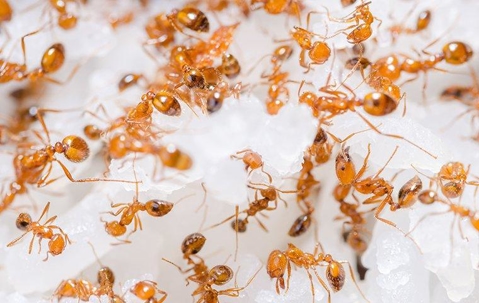More than 10,000 species of Ants (Formicidae) exist worldwide and more than 700 species in the U.S. As largely social insects, ants will create large underground nests (colonies) consisting of groups including soldiers, workers, and queens. Ants are generally omnivorous and create tunnels as they forage for food sources. An ant's body has three sections, a thin waist, compound eyes, six legs, and bent (elbowed) antennae.
The red imported fire ant (Solenopsis Invicta) is a highly invasive ant species that will arrive on a property, form a massive colony, and expel other ants and other types of insects from the premises. This foreign species is distinct from the native Solenopsis Geminata or tropical fire ant and Solenopsis Xyloni or southern fire ant. The University of Florida's Entomology & Nematology explains that the red imported fire ant species first arrived in Mobile, Alabama, or Pensacola, Florida, during the 1930s from South America.
The red imported fire ant appears in shades of red and brown and has a body length ranging from 1/8 to 3/8 of an inch. Fire ants usually will respond aggressively in groups and begin stinging a human or animal that appears threatening.
Has a fire ant colony developed on your property? Homeowners should consult with a licensed pest controller for assistance with undesirable critters. A professional Pensacola pest control company understands how fire ants behave and how to get rid of fire ants in yard areas safely.
When Are Fire Ants The Most Active?
Fire ant activity in Pensacola is generally highest when temperatures range from 72 to 96 degrees Fahrenheit and typically extend up to 100 feet from the nest. Although predominately an outdoor pest, red imported fire ants will sometimes enter homes.
What are some of the symptoms of fire ant stings? Victims of fire ant stings usually experience pain, and pustules may form on the skin. Some individuals will have allergic reactions that may require medical attention.
Fire Ant Mounds: What To Do If You Spot Them
Have you noticed what appears as a fire ant mound in your yard? They often occur after rainfalls in sunny yard areas and resemble accumulations of dirt. Homeowners should consider the following best practices when encountering fire ant mounds:
- Avoid directly disturbing the area, as fire ants will likely defend their nest in groups.
- Always place trash bags containing food scraps in durable, sealed garbage receptacles.
- Do not place pet food bowls out on decks or patios.
When responding to these potentially harmful pests, the best course of action is to contact a local pest control company for assistance.
Why Home Remedies For Fire Ants Don't Work
A fire ant colony on your property poses safety risks, and these nests become massive. A queen fire ant might produce over 800 eggs in a day. Store-bought treatment options or home remedies often prove insufficient for completely eradicating fire ant colonies. Speaking with a local pest controller is strongly suggested when encountering fire ants.
Getting Rid Of Fire Ants In Your Pensacola Lawn
EnSec Pest & Lawn employs a staff of specialists that are very familiar with the activities and behaviors of fire ants. Our well-qualified service team members know what attracts fire ants and how to get rid of fire ant hills that exist in yard areas. We initially developed and continue improving our fire ant treatment programs.
Because fire ants construct underground nests, our service team members often begin by treating the soil with a product that enters the ground and remains active for roughly one year. This effective subterranean solution will substantially reduce the likelihood of fire ants returning to that area for the duration. As we wait for the absorption and full activation of the soil formula, we may use a baiting option.
We encourage Pensacola property owners with pest-related concerns to reach us today.

